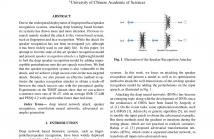
ICASSP is the world’s largest and most comprehensive technical conference focused on signal processing and its applications. The ICASSP 2020 conference will feature world-class presentations by internationally renowned speakers, cutting-edge session topics and provide a fantastic opportunity to network with like-minded professionals from around the world. Visit website.

- Read more about Optimal Power Flow Using Graph Neural Networks
- Log in to post comments
Optimal power flow (OPF) is one of the most important optimization problems in the energy industry. In its simplest form, OPF attempts to find the optimal power that the generators within the grid have to produce to satisfy a given demand. Optimality is measured with respect to the cost that each generator incurs in producing this power. The OPF problem is non-convex due to the sinusoidal nature of electrical generation and thus is difficult to solve.
- Categories:
 157 Views
157 Views
- Read more about EnerGAN: A Generative Adversarial Network for Energy Disaggregation
- Log in to post comments
An efficient, appliance-level approach for energy disaggregation, exploiting the benefits of Generative Adversarial Networks, is presented. The concept of adversarial training supports the creation of fine tuned disaggregators, which produce more detailed load estimations for a specific appliance, compared to state of the art deep learning models. The Generator and Discriminator of the model are appropriately adapted to fit the particularities of NILM problem, whereas a Seeder component is added to provide encoded compact input vectors to the Generator.
- Categories:
 123 Views
123 Views
- Read more about Learning to Fool the Speaker Recognition (poster)
- Log in to post comments
Due to the widespread deployment of fingerprint/face/speaker recognition systems, attacking deep learning based biometric systems has drawn more and more attention. Previous research mainly studied the attack to the vision-based system, such as fingerprint and face recognition. While the attack for speaker recognition has not been investigated yet, although it has been widely used in our daily life.
- Categories:
 103 Views
103 Views
- Read more about dMazeRunner: Optimizing Convolutions on Dataflow Accelerators
- Log in to post comments
- Categories:
 39 Views
39 Views
- Read more about dMazeRunner: Optimizing Convolutions on Dataflow Accelerators
- Log in to post comments
- Categories:
 21 Views
21 Views
- Read more about dMazeRunner: Optimizing Convolutions on Dataflow Accelerators
- Log in to post comments
- Categories:
 29 Views
29 Views
- Read more about Libri-Light: A Benchmark for ASR with Limited or No Supervision- ICASSP 2020 Slides
- Log in to post comments
- Categories:
 164 Views
164 Views
- Read more about DOA ESTIMATION IN SYSTEMS WITH NONLINEARITIES FOR MMWAVE COMMUNICATIONS
- 1 comment
- Log in to post comments
Accurate and efficient methods for Direction of Arrival (DOA) estimation play an important role in mmWave channel estimation methods. This estimation procedure can potentially be affected by the different RF and analog components in the communication system. Such components add an unknown, nonlinear distortion to the received signal. This work looks at addressing this problem of DOA estimation for a general case of a nonlinear distortion of the received signal. Two different scenarios for angle recovery are considered here: with the use of pilot symbols and without the use of pilots.
- Categories:
 53 Views
53 Views
We address the problem of filtering out localized time-frequency components in signals. The problem is formulatedas a minimization of a suitable quadratic form, that involves adata fidelity term on the short-time Fourier transform outsidethe support of the undesired component, and an energy pe-nalization term inside the support. The minimization yields alinear system whose solution can be expressed in closed formusing Gabor multipliers.
- Categories:
 74 Views
74 Views